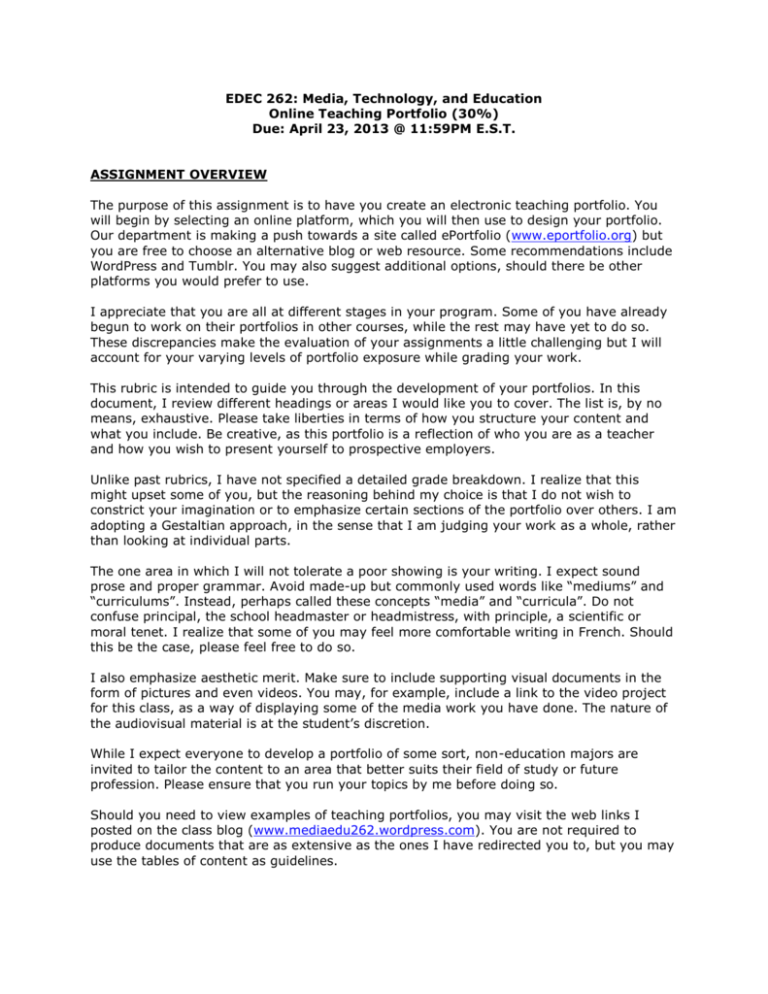EDEC 262 – Winter 13 – Final assignment
advertisement

EDEC 262: Media, Technology, and Education Online Teaching Portfolio (30%) Due: April 23, 2013 @ 11:59PM E.S.T. ASSIGNMENT OVERVIEW The purpose of this assignment is to have you create an electronic teaching portfolio. You will begin by selecting an online platform, which you will then use to design your portfolio. Our department is making a push towards a site called ePortfolio (www.eportfolio.org) but you are free to choose an alternative blog or web resource. Some recommendations include WordPress and Tumblr. You may also suggest additional options, should there be other platforms you would prefer to use. I appreciate that you are all at different stages in your program. Some of you have already begun to work on their portfolios in other courses, while the rest may have yet to do so. These discrepancies make the evaluation of your assignments a little challenging but I will account for your varying levels of portfolio exposure while grading your work. This rubric is intended to guide you through the development of your portfolios. In this document, I review different headings or areas I would like you to cover. The list is, by no means, exhaustive. Please take liberties in terms of how you structure your content and what you include. Be creative, as this portfolio is a reflection of who you are as a teacher and how you wish to present yourself to prospective employers. Unlike past rubrics, I have not specified a detailed grade breakdown. I realize that this might upset some of you, but the reasoning behind my choice is that I do not wish to constrict your imagination or to emphasize certain sections of the portfolio over others. I am adopting a Gestaltian approach, in the sense that I am judging your work as a whole, rather than looking at individual parts. The one area in which I will not tolerate a poor showing is your writing. I expect sound prose and proper grammar. Avoid made-up but commonly used words like “mediums” and “curriculums”. Instead, perhaps called these concepts “media” and “curricula”. Do not confuse principal, the school headmaster or headmistress, with principle, a scientific or moral tenet. I realize that some of you may feel more comfortable writing in French. Should this be the case, please feel free to do so. I also emphasize aesthetic merit. Make sure to include supporting visual documents in the form of pictures and even videos. You may, for example, include a link to the video project for this class, as a way of displaying some of the media work you have done. The nature of the audiovisual material is at the student’s discretion. While I expect everyone to develop a portfolio of some sort, non-education majors are invited to tailor the content to an area that better suits their field of study or future profession. Please ensure that you run your topics by me before doing so. Should you need to view examples of teaching portfolios, you may visit the web links I posted on the class blog (www.mediaedu262.wordpress.com). You are not required to produce documents that are as extensive as the ones I have redirected you to, but you may use the tables of content as guidelines. ASSIGNMENT SUBMISSION Please e-mail a web link to your electronic portfolio to mediaedu262@gmail.com by or before April 23, 2013. While I am generally flexible with submission dates, I cannot provide you with any extension on the final assignment unless you have written documentation as to why you require additional time. I need this paperwork to justify a delay in grade input to the department. PORTFOLIO CONTENT 1- Biography/About me (though not “All about me”) This section will help your readers get acquainted with you. We are all the stars of our own movie and, in most cases, believe these motion pictures to be Academy Award worthy. Others may be less enamored with your life than you are. Avoid pointless anecdotes and try to focus on the life experiences that have shaped who you are and how you see the world. For those of you who may not know, C.V. is short for curriculum vitae – the curriculum of a life. Be explicit about what your life has taught you and why this knowledge is important. What impact have these life lessons had on your personal outlook, your values, attitudes, etc? This may require a fair amount of personal reflection. As a brief example, my defining life experiences include a nomadic upbringing that saw my family relocate every 3 to 4 years. This caused a fair amount of upheaval but allowed me to develop the ability to adapt to the demands of my environment. Also, the exposure I received to different cultures, languages and schooling systems has allowed me to remain flexible in my interactions with people whose philosophies differ from my own. These experiences have helped me become more tolerant and patient as a teacher. 2- Professional goals and pedagogic aspirations Tell your readers what grades or age group you hope to engage, what kind of schools you would like to work in (public, private, alternative) and the subject areas you would like to teach. You might include this as a separate section of embed it in your biography. You may also choose to reflect on why you’ve made the previously stated choices. What is it about working with primary students that you find more rewarding than secondary students, or vice versa? What attracted you to your teachable subject? 3- Teaching philosophy In a nutshell, how do you view teaching? Here, you can elaborate on your attitudes towards student-teacher dynamics, perhaps speak to specific “classroom management” techniques, or address issues of diversity in schools. How will you design your curriculums curricula to better reflect your students’ lived experiences? Because this is a course on media and education, I ask that you touch on the pedagogic potential of various forms of media. How do you see yourself integrating media and technology into your practice? 4- Past teaching experiences Here, include any teaching-related internship you may have completed, volunteer work you may have done or job you may have held. Take a broad approach to teaching and go beyond school-based experiences. Include community organizations you may have been involved with or any education programs you contributed to. You might include a brief description of the school/organization, perhaps include reference letters and a list of tasks you carried out. Try to upload all supporting documents as attachments so as not to clutter your page. Doing so also allows prospective employees to download your references and keep them on file. Should you choose to do so, you may upload a copy of your resume. 5- Honors, awards, distinctions This is relatively self-explanatory. Include a list of academic and non-academic awards you might have received. These can include athletic scholarships, grants, other forms of funding, making the dean’s list, etc… 6- Lesson plan Traditionally, this section was the focus of the assignment. I realize that some of you may not have designed lesson plans before but this might be a good place to start. Develop a unit plan consisting of 3 lessons. You should have an umbrella topic (i.e. a running theme) throughout these lessons, so that they form a coherent whole rather than remain discrete units. Your are free to tackle any subject of your choosing, but are required to integrate the use of media in at least 2 out of the 3 lessons. Please refer to the following guidelines: Topic: Have a title for the unit plan Explain what your unit plan is about Name who the lesson plan has been designed for (your target population) Rationale: Explain why you chose your topic and how it ties into broader social issues Explain how it is relevant to your students’ lived realities Include a brief list of objectives Materials: List the resources and materials needed to implement your individual lessons State when and how they will be used More specific materials can be listed in each individual lesson plan Lesson plan (THREE lessons): Must have at least 2 lessons with media as a teaching tool Explain how you plan to teach the material needed to complete course objectives. Do not assume that your students have prior knowledge on how to use or analyze the forms of media you introduce Embed all of your media links – these can consist of pictures, videos, music, etc… Ensure that your links all work. Dead (non-working links) will not be considered for review List specific materials needed (digital/analog, hardware/software) Must be thorough enough in the description that a substitute could fill in without much trouble Indicate length of activities If using worksheets or questions they are to be self-made, not taken from internet. Games can be linked to ones found online. Overall organization up to your discretion Assessment: Can be a one-time affair assessing the entire unit, can be done each lesson or every few, etc. Have a detailed explanation on how you are going to assess the students and why you chose your methods of assessment Include any essay questions, quizzes, worksheets, etc. that are going to be used to assess the students Include a rubric if you so desire (this is encouraged, as students will likely ask for one) Below are links to older unit plans that were awarded full marks. (Please note that these assignments were completed using a slightly different rubric): http://amelielemieux.wordpress.com/ http://lizyzimmerman.wordpress.com/ http://gohtbyeolkim.wordpress.com/ http://debrajohns.wordpress.com/ http://melissaraymondsblog.wordpress.com/ http://anneconstancemarie.wordpress.com/ http://tara318.wordpress.com/ The following are links to assignments that were at the lower end of the grade spectrum: http://dijanaetienne.wordpress.com/ http://sforest27.wordpress.com/ http://jschaye.wordpress.com/



